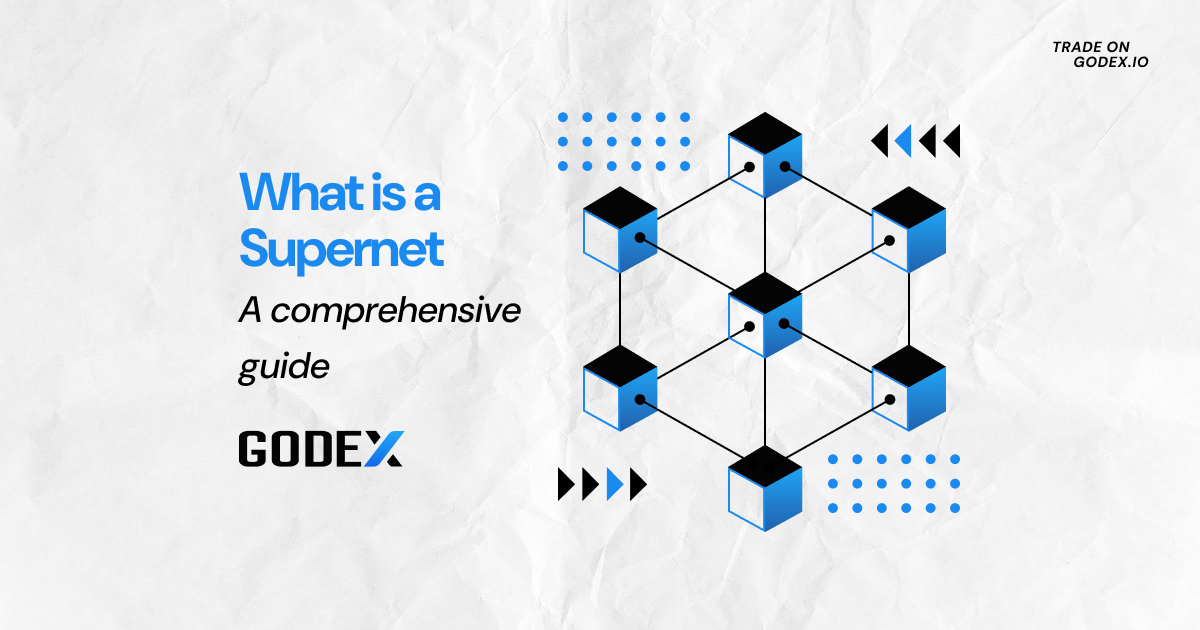Table of Contents
The primary goal of a supernet is to establish a decentralized network where different blockchain platforms can interact and exchange information without relying on a centralized entity, thus forming an integrated ecosystem. This setup can greatly enhance the efficiency and speed of transactions and communications across multiple blockchains.
So, what is a supernet? Keep reading to discover the answer as well as the whole science behind the network and its architecture.
Exploring the Fundamentals of a Supernet
Also referred to as a metanet, it is a sophisticated network architecture that enables interoperability and seamless communication among various blockchain networks.
Additionally, a supernet offers the advantage of supporting the creation of new decentralized services and applications that leverage the unique strengths of various blockchains. This integration can drive innovation and growth within the blockchain sector. One notable feature of a supernet is cross-chain communication, which allows different blockchains to connect and conduct transactions with each other, thereby increasing value for users.
Defining the concept and its relevance in networking.
What is supernetting? Developed to overcome the limitations of classful IP addressing, supernetting allows for flexible network sizing and reduces routing complexity.
Unlike the fixed blocks of classful systems, supernetting, or Classless Inter-Domain Routing (CIDR), enables combining smaller networks into larger ones, optimizing address allocation. While it introduced complexities like new routing protocols and CIDR notation, supernetting significantly improves efficiency by supporting route aggregation and allowing customized network sizes to meet organizational needs.
Understanding the inner workings of how a Supernet operates.
A supernet operates using the route summarization technique. By combining multiple networks with similar prefixes into a single routing entry, a supernet is created that includes all those networks. This approach significantly reduces the size of routing tables and helps prevent network exhaustion.
Certain conditions must be met for networks to be merged into a supernet. First, all networks must be contiguous, meaning their network IDs must be in a sequential series. If you add 1 to the network ID of the first network, it should match the next network’s ID. Second, all networks must be of the same size, supporting an equal number of hosts. Finally, the first IP address in the range should be divisible by the total size of the supernet.
Crafting a Supernet: From Theory to Implementation
Additional routers to handle increased load is one of the things to consider before creating this network architecture. To create a supernet, ensure networks are contiguous, of equal size, and in powers of two.
Each network must be divisible by the first network ID. A supernet calculator simplifies this process, reducing errors. The first IP block’s non-common octet should be zero or a multiple of the number of networks being aggregated. Convert the route into CIDR notation.
Necessary information includes the CIDR value, network ID, broadcast ID of each router, subnet mask, and block size.
So, what to do next?
- Identify networks to merge, ensuring they have similar protocols and goals.
- Deploy atomic swaps for asset transfers between blockchains.
- Create cross-chain communication protocols.
- Develop sidechains.
Test the infrastructure thoroughly before full deployment to identify and fix any issues.
Advantages and Drawbacks
To work on this project, the personnel needs to be sort of ‘tech-savvy’ and have expertise in blockchain networks, including blockchain trillemma, and the necessary software and hardware. Besides, its implementation is costly in terms of acquiring software, hardware, and needed minds. Herewith, not all network devices or software are CIDR-compatible, which can cause challenges during implementation.
There are also safety risks as merging diverse networks into a supernet exposes it to vulnerabilities.
Supernetting provides numerous advantages:
- It enhances the speed and efficiency of transactions and communication among different blockchain networks.
- It enables users to communicate, trade, and manage assets across multiple blockchains, utilizing atomic cross-chain trades and side chains for seamless interaction.
- Supernetting facilitates easy connections and transactions between different blockchains, increasing value for users.
- By reducing reliance on centralized intermediaries, supernetting supports decentralized apps and platforms that operate across multiple blockchains.
- It optimizes IP address usage and helps routers manage network traffic more effectively by reducing the number of routes in the routing table.
- Consolidating several networks into one supernet simplifies management and configuration tasks.
- Combining multiple networks into a supernet conserves IP addresses, preventing their exhaustion.
- Managing fewer networks decreases the risk of hacking, promising better security.
- Supernetting helps to lower overall network traffic.
Managing Supernets Effectively
Managing supernets requires a comprehensive approach to planning, security, and maintenance. Here are some essential strategies and practices to ensure effective management:
Strategies for Developing a Comprehensive Network Plan and Establishing Governance
Effective management of a supernet begins with developing a thorough network plan. This involves setting clear goals and objectives and identifying the specific requirements of each network included in the supernet. Establishing governance is also crucial, with clear lines of responsibility and decision-making processes. This includes determining who will manage the network, who will have access, and who can make configuration changes. Training staff is essential, ensuring they have the necessary skills to set up and operate the network, and are familiar with the specific technologies and protocols used.
Security Measures for Supernets
Security is a critical aspect of managing supernets. Implement appropriate security measures such as firewalls, intrusion detection, and prevention systems to protect the network. Regularly monitor and maintain the network to ensure it is functioning effectively and to quickly address any issues. Use centralized management tools to simplify oversight and keep software updated to protect against vulnerabilities and run the latest security patches.
Supernet Maintenance
Regular maintenance is vital for a supernet’s smooth operation. Documenting and troubleshooting the network makes it easier to manage. Regular testing, including penetration testing and other security assessments, helps identify and resolve potential issues. Consistent monitoring and updating ensure the network remains secure and efficient.
Supernet vs. Subnet: Unraveling the Differences
A smaller network, known as a subnet or subnetwork, is created by dividing a larger network into more manageable segments. Subnetting enhances network organization and security by breaking it into smaller, independent sections.
Each subnet can operate and be managed separately, with its own unique set of network addresses. This practice is common in large-scale networks, such as those utilized by businesses or organizations. Conversely, a supernet is formed by linking multiple networks together, allowing them to interact and communicate within a unified ecosystem.
Conclusion
Supernetting is highly useful because it enhances the efficiency and speed of transactions across multiple blockchains while reducing reliance on centralized intermediaries. It optimizes IP address usage and simplifies network management, contributing to a more organized and secure network environment. Additionally, it supports the creation and interaction of decentralized applications, driving innovation and growth in the blockchain sector.
FAQ
What is the primary purpose of Supernetting in network architecture?
The primary purpose of supernetting is to establish a decentralized network where different blockchain platforms can interact and exchange information without relying on a centralized entity, forming an integrated ecosystem.
How does Supernetting differ from traditional networking approaches?
Supernetting differs from traditional networking approaches by combining smaller networks into larger ones, using Classless Inter-Domain Routing (CIDR), which allows for flexible network sizing and reduces routing complexity compared to fixed block allocations in classful systems.
What are the key advantages of implementing Supernetting in a network?
The key advantages of supernetting include enhanced transaction speed and communication efficiency among blockchains, optimized IP address usage, simplified management, improved security by reducing the number of networks, and the ability to support decentralized apps and cross-chain transactions.
Start a Cryptocurrency exchange
Try our crypto exchange platform
Disclaimer: Please keep in mind that the content of this article is not financial or investing advice. The information provided is the author’s opinion only and should not be considered as direct recommendations for trading or investment. Any article reader or website visitor should consider multiple viewpoints and become familiar with all local regulations before cryptocurrency investment. We do not make any warranties about reliability and accuracy of this information.
 Alex Tamm
Alex Tamm 
Read more
Ripple (XRP) price has been widely discussed by the cryptocurrency community since it has gained public interest in 2017, even though it was founded by Chris Larsen and Jed McCaleb years before. The platform offers innovative blockchain solutions for the banking sector and has the potential to disrupt the whole finance industry. In recent years, […]
In this article we will talk about Ripple (XRP) and its price prediction. What is Ripple (XRP) Ripple is a San Francisco-based startup that was launched in 2012 by Ripple Labs as a global network both for cross-currency and gross payments. Ripple history began in 2004 with the discussions around the digital coin in the […]
You may well think that an article dedicated to a Tether price prediction or the Tether price in general is a little bit strange — it is a stablecoin after all. However, the price of Tether does fluctuate significantly, although it is nowhere near as volatile as non-stablecoin cryptos. This means that staying up to […]
In the article we share our vision at Zcash cryptocurrency main features and add several price predictions. As cryptocurrencies gain global acceptance and decentralisation slowly enters our lives, privacy becomes the main concern when talking about blockchain adoption. It is no secret that distributed ledger is by far the most secure and transparent technology ever […]
Chiliz coin (CHZ) offers a compelling opportunity for traders interested in the intersection of blockchain technology and sports. By enabling fans to influence team decisions through the Socios app, Chiliz directly monetizes fan engagement and connects with major sports teams like Juventus and Paris Saint-Germain. These partnerships not only enhance the platform’s visibility but also […]
The exponential growth of Bitcoin Satoshi Vision (BSV) against the general bear trend on the cryptocurrency market in autumn 2019 has impressed the community. Due to the increasing market capitalization, the newly emerged altcoin was ranked 5th on CoinMarketCap and managed to maintain its high position at the beginning of 2020. In the article we […]